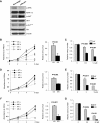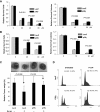p38γ mitogen-activated protein kinase contributes to oncogenic properties maintenance and resistance to poly (ADP-ribose)-polymerase-1 inhibition in breast cancer
- PMID: 21532888
- PMCID: PMC3084624
- DOI: 10.1593/neo.101748
p38γ mitogen-activated protein kinase contributes to oncogenic properties maintenance and resistance to poly (ADP-ribose)-polymerase-1 inhibition in breast cancer
Abstract
p38γ MAPK, one of the four members of p38 mitogen-activated protein kinases (MAPKs), has previously been shown to harbor oncogenic functions. However, the biologic function of p38γ MAPK in breast cancer has not been well defined. In this study, we have shown that p38γ MAPK is overexpressed in highly metastatic human and mouse breast cancer cell lines and p38γ MAPK expression is preferentially associated with basal-like and metastatic phenotypes of breast tumor samples. Ectopic expression of p38γ MAPK did not lead to an increase in oncogenic properties in vitro in most tested mammary epithelial cells. However, knockdown of p38γ MAPK expression resulted in a dramatic decrease in cell proliferation, colony formation, cell migration, invasion in vitro and significant retardation of tumorigenesis, and long-distance metastasis to the lungs in vivo. Moreover, knockdown of p38γ MAPK triggered the activation of AKT signaling. Inhibition of this feedback loop with various PI3K/AKT signaling inhibitors facilitated the effect of targeting p38γ MAPK. We further found that overexpression of p38γ MAPK did not promote cell resistance to chemotherapeutic agents doxorubicin and paclitaxel but significantly increased cell resistance to PJ-34, a DNA damage agent poly (ADP-ribose)-polymerase-1 (PARP) inhibitor in vitro and in vivo. Finally, we identified that p38γ MAPK overexpression led to marked cell cycle arrest in G(2)/M phase. Our study for the first time clearly demonstrates that p38γ MAPK is a promising target for the design of targeted therapies for basal-like breast cancer with metastatic characteristics and for overcoming potential resistance against the PARP inhibitor.
Figures







Similar articles
-
ErbB2 and p38γ MAPK mediate alcohol-induced increase in breast cancer stem cells and metastasis.Mol Cancer. 2016 Jul 14;15(1):52. doi: 10.1186/s12943-016-0532-4. Mol Cancer. 2016. PMID: 27416801 Free PMC article.
-
Calycosin suppresses breast cancer cell growth via ERβ-dependent regulation of IGF-1R, p38 MAPK and PI3K/Akt pathways.PLoS One. 2014 Mar 11;9(3):e91245. doi: 10.1371/journal.pone.0091245. eCollection 2014. PLoS One. 2014. PMID: 24618835 Free PMC article.
-
Impact of p38γ mitogen-activated protein kinase (MAPK) on MDA-MB-231 breast cancer cells using metabolomic approach.Int J Biochem Cell Biol. 2019 Feb;107:6-13. doi: 10.1016/j.biocel.2018.11.002. Epub 2018 Nov 14. Int J Biochem Cell Biol. 2019. PMID: 30447427
-
P38 kinase in gastrointestinal cancers.Cancer Gene Ther. 2023 Sep;30(9):1181-1189. doi: 10.1038/s41417-023-00622-1. Epub 2023 May 29. Cancer Gene Ther. 2023. PMID: 37248432 Free PMC article. Review.
-
p38γ MAPK Inflammatory and Metabolic Signaling in Physiology and Disease.Cells. 2023 Jun 21;12(13):1674. doi: 10.3390/cells12131674. Cells. 2023. PMID: 37443708 Free PMC article. Review.
Cited by
-
Oncogenic Signaling in Tumorigenesis and Applications of siRNA Nanotherapeutics in Breast Cancer.Cancers (Basel). 2019 May 6;11(5):632. doi: 10.3390/cancers11050632. Cancers (Basel). 2019. PMID: 31064156 Free PMC article. Review.
-
The role of Th-17 cells and IL-17 in the metastatic spread of breast cancer: As a means of prognosis and therapeutic target.Front Immunol. 2023 Mar 13;14:1094823. doi: 10.3389/fimmu.2023.1094823. eCollection 2023. Front Immunol. 2023. PMID: 36993955 Free PMC article. Review.
-
Phosphorylation of cell cycle and apoptosis regulatory protein-1 by stress activated protein kinase P38γ is a novel mechanism of apoptosis signaling by genotoxic chemotherapy.Front Oncol. 2024 May 2;14:1376666. doi: 10.3389/fonc.2024.1376666. eCollection 2024. Front Oncol. 2024. PMID: 38756656 Free PMC article.
-
p38γ MAPK is required for inflammation-associated colon tumorigenesis.Oncogene. 2016 Feb 25;35(8):1039-48. doi: 10.1038/onc.2015.158. Epub 2015 May 11. Oncogene. 2016. PMID: 25961922
-
ErbB2 and p38γ MAPK mediate alcohol-induced increase in breast cancer stem cells and metastasis.Mol Cancer. 2016 Jul 14;15(1):52. doi: 10.1186/s12943-016-0532-4. Mol Cancer. 2016. PMID: 27416801 Free PMC article.
References
-
- Cuenda A, Rousseau S. p38 MAP-kinases pathway regulation, function and role in human diseases. Biochim Biophys Acta. 2007;1773:1358–1375. - PubMed
-
- Dhanasekaran DN, Johnson GL. MAPKs: function, regulation, role in cancer and therapeutic targeting. Oncogene. 2007;26:3097–3099. - PubMed
-
- Han J, Lee JD, Bibbs L, Ulevitch RJ. A MAP kinase targeted by endotoxin and hyperosmolarity in mammalian cells. Science. 1994;265:808–811. - PubMed
-
- Jiang Y, Chen C, Li Z, Guo W, Gegner JA, Lin S, Han J. Characterization of the structure and function of a new mitogen-activated protein kinase (p38β) J Biol Chem. 1996;271:17920–17926. - PubMed
Publication types
MeSH terms
Substances
LinkOut - more resources
Full Text Sources
Medical
Molecular Biology Databases
Miscellaneous
